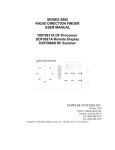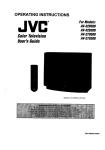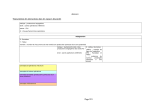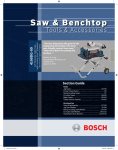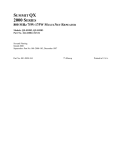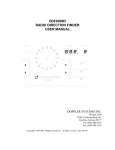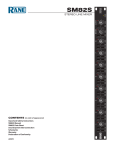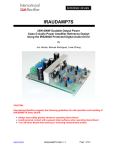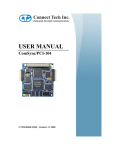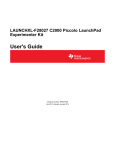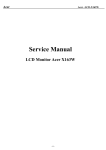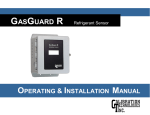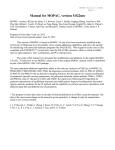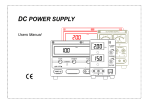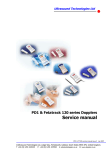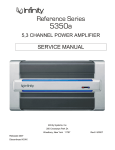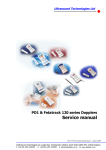Download SERIES 5900 RADIO DIRECTION FINDER USER MANUAL
Transcript
SERIES 5900 RADIO DIRECTION FINDER USER MANUAL DDF5911A DF Processor DDF5921A Remote Display DDF5950A/5960A RF Summer 0 315 45 270 90 225 135 180 AVG ATTEN VOL DIM CAL VOL DOPPLER SYSTEMS INC. PO Box 2780 37202 N. Bloody Basin Rd. Carefree, Arizona 85377 Tel: (480) 488-9755 Fax: (480) 488-1295 Copyright 8 1999, Doppler Systems Inc. All rights reserved. Rev. A - Issue 2002/11. Warranty Information Doppler Systems Inc. will repair or replace, at their option, any parts found to be defective in either materials or workmanship for a period of one year from the date of shipping. Defective parts must be returned for replacement. In the US, contact the factory, or overseas your local distributor, for advice about returning any defective parts or equipment. If a defective part or design error causes your radio direction finder to operate improperly during the one-year warranty period, Doppler Systems Inc. will service it free of charge if returned at owner’s expense. If improper operation is due to an error on the part of the purchaser, there will be a repair charge. Doppler Systems Inc. are not responsible for damage caused by the use of improper tools or solder, failure to follow the printed instructions, misuse or abuse, unauthorized modifications, misapplication of the unit, theft, fire or accidents. This warranty applies only to the equipment sold by Doppler Systems Inc. and does not cover incidental or consequential damages. Doppler Systems radio direction finding equipment is designed to help locate the source of interfering, emergency or unauthorized transmissions, or others coming from marker and rescue beacons, etc., and is not intended to be used as a navigation aid. In particular it is not to be used for aircraft or marine navigation. Accessories Included With the DDF5911 processor assembly: (1) User Manual (1) Cigar lighter to 2.5 mm dc power plug cable #DDF6110 (1) 3.5 mm phone plug to 3.5 mm phone plug cable #40DK40 (1) 3.5 mm phone plug to RCA phono plug cable #40DK25 (2) 3.5 mm phone plug #750 (1) 2.5 mm dc power cable #4201 With the DDF5921 display assembly: (1) DB9S to DB9P cable #DDF6203 (1) Windshield mounting kit With the DDF5950 or DDF5960 RF summer assembly: (1) Control cable #DDF6119 (1) Coax cable #DDF6116 Table of Contents 1.0 Introduction ...............................................................................................................................1 2.0 Specifications.............................................................................................................................2 3.0 Controls and Connectors............................................................................................................4 4.0 Installation ...............................................................................................................................10 5.0 Operation..................................................................................................................................14 6.0 PC Control and Advanced Topics............................................................................................16 7.0 Servicing .................................................................................................................................23 1.0 Introduction The Series DDF5900 is a high performance radio direction finding system that operates using the simulated Doppler principle in which the outputs of a circular array of antennas are combined in a way that simulates a single element rotating in a circular path. As the simulated element approaches the wave front of an rf signal, the frequency of its output increases due to the Doppler effect, and as it recedes from the transmitted source, the frequency decreases. The amount of frequency change (deviation) is related to the speed of rotation and the diameter of the antenna array, while the modulation frequency is equal to the frequency of rotation (the antenna sweep frequency). When connected to a narrow band communication receiver, the sweep frequency is present on the audio output. To obtain the bearing angle, the direction finder processes this audio output. Many features are present in the Series DDF5900 comprising the 5911A processor, 5921A display and 5950A or 5960A rf summer: C A small remote display unit puts the bearing and signal strength LEDs and all controls close to the operator. It can be conveniently mounted on a vehicle windshield. C A remote rf summing unit eliminates the need for matched coaxial cables and provides broadband frequency coverage from 50 to 1000 MHz. C Advanced signal processing is used to detect the signal with the receiver either squelched or unsquelched. Both continuous and 150 millisecond pulsed signals can be processed. C The sweep direction automatically reverses from clockwise to counterclockwise to compensate for asymmetries in the receiver. C An internal audio amplifier and loudspeaker are provided for monitoring the signal, and a sharp notch filter removes the sweep frequency for clarity. C The remote display can be replaced by a PC using a standard RS232 connection. The PC can then be used to select optional bearing processing parameters (pulse correlation intervals, etc.) which are retained in non-volatile memory. C All electronics are housed in metal enclosures for durability and enhanced electromagnetic compatibility (EMC). Antennas are constructed of corrosion resistant materials and are designed for wind speeds up to 45 m/s (100 mph). 1 2.0 Specifications Performance specifications apply to a DDF5900 when connected to a narrow band fm receiver such as the Icom R7000, R7100 or R8500. Frequency range (Magnetic mounted antenna) 50-88 MHZ (DDF5968) 88-136 MHZ (DDF5961) 136-500 MHZ (DDF5962) 700-1000 MHZ (DDF5967) Frequency range (Mast mounted antenna) 125-175 MHZ (DDF5952) 350-500 MHZ (DDF5955) 700-1000 MHZ (DDF5957) Bearing display 16 LED circle and 3 digit LED display S-meter display 10 segment color LED bar graph Display update rate 2 per second Display hold 10 seconds Bearing accuracy (1 sigma) 5 degrees DF sensitivity (typical) -126 dBm, continuous signal -120 dBm, pulsed signal Bearing averaging (selectable) 2 or 4 samples (Simulated) antenna rotation rate 1229 Hz RF attenuator (selectable) 0 or 20 dB Audio input range 0.01 to 0.6 VRMS Audio output 0.5 watts maximum S-meter input range +0.25 to +8.5 VDC Serial interface RS232, 4800 Baud, 8N1, ASCII Power requirement 11 to 14 VDC Current consumption 0.7 amp 2 Operating temperature 0 to 50 degrees C (display and processor) -50 to 100 degrees C (rf summer and antenna) Dimensions (processor - H x W x D) (display - H x W x D) (Rf summer - H x W x D) 32 x 216 x 140 mm (1.25 x 8.5 x 5.5 in) 60 x 114 x 32 mm (2.375 x 4.5 x 1.25 in) 57 x 102 x 121 mm (2.25 x 4 x 4.75 in) Weight (processor) (display) (Rf summer) 0.635 kg (1.40 lbs) 0.236 kg (0.52 lbs) 0.544 kg (1.20 lbs) 3 3.0 Controls and Connectors Figures 3-1, 3-2 and 3-3 shows the controls, displays and connectors provided on the DDF5921 remote display, the DDF5911 processor and the DDF5950/5960 RF summer . The items marked • in the following paragraphs refer to the items shown in these figures. The values given in the paragraphs below are those that are provided by the factory default settings, which will normally be used. Refer to Section 6 for a discussion of alternate settings. •1 The center yellow LED indicates that power is applied. •2 The bearing is displayed by illumination of one of the red LEDs on the circular display. •3 The signal strength is indicated in this 10-segment display. It should be calibrated so that the signal strength is 1 when a very weak signal is present and 9 when a very strong signal is present. As shipped from the factory, the S-meter and Bearing are calibrated for an Icom R8500 receiver. To calibrate the unit for other receivers, refer to paragraph 6.5. •4 Bearing angles in degrees are displayed in the 7-segment display. Both the circular LED display and the digital display are held for 10 seconds after the signal disappears. To help distinguish when the bearing is updating and when it is being held, the decimal point following the units digit alternates ON to OFF whenever the bearing updates. •5 Bearing data is computed twice per second. The front panel displays a moving average of the last N bearings calculated. Normally, the number of bearings averaged is equal to 2; that is, one clockwise and one counterclockwise. Pressing this switch causes the number of bearings averaged to be increased from 2 to 4. Pressing it again restores the number averaged to 2. When 4 averages have been selected, the small LED following the hundreds digit (directly above this switch) in the seven segment display •4, is illuminated. •6 The front panel LEDs may be dimmed by momentarily pressing this switch. Pressing it again returns the LEDs to full brightness. •7 Pressing this switch causes a 20 dB attenuation of the rf input to the commutation electronics. Pressing it again removes the 20 dB attenuation. The LED next to the tens digit (directly above this switch) on the seven segment display •4, is illuminated when the 20 dB attenuation is applied. •8 Pressing this switch causes the bearing of the signal being received to be set to 0 degrees. •9 Pressing this switch causes the volume to be increased in steps of 4 dB over a range of 20 dB. Hold the switch down or press it repeatedly to increase the volume to the level desired. 4 •10 This switch reduces the volume in steps of 4 dB over a range of 20 dB. •11 Connect to the DB9S connector on the cable supplied with the remote display. This cable connects the remote display to the processor. •12 J1, DC power input. Connect to +12 VDC using the supplied 2.5mm to cigar plug cable. •13 J2, DC power output. Connect to +12 VDC receiver using the supplied 2.5mm cable. Do not exceed 2 amps. •14 J3, external speaker output. May be connected to an external speaker (not supplied) using one of the supplied 3.5 mm plugs. •15 J4, receiver audio input. Connect to the external speaker output of your receiver using the supplied 3.5 mm to 3.5 mm cable or make a custom cable using one of the supplied 3.5 mm plugs. •16 J5, RSS input. Connect to the receiver’s received signal strength (RSS) output using the supplied 3.5 mm to RCA phono jack cable or make a custom cable using one of the supplied 3.5 mm plugs. •17 J6, remote display output. Connect to the DB9P connector on the cable supplied with the remote display or use the same cable to connect to a PC for operation as described in Section 6. •18 J7, antenna control cable output. Connect to the DA15P connector on the cable supplied with the rf summer. •19 Antenna A input. Connect to the left front antenna element. •20 Antenna B input. Connect to the left rear antenna element. •21 Antenna C input. Connect to the right rear antenna element. •22 Antenna D input. Connect to the right front antenna element. •23 Antenna control cable input. Connect to the 9 pin circular connector on the cable supplied with the rf summer. This cable connects the rf summer to the processor. •24 RF output. Connect to the TNC connector on the coax cable supplied with the rf summer and connect the BNC end of this cable to the receiver’s antenna input. 5 0 315 45 270 90 225 135 180 AVG ATTEN VOL DIM CAL VOL Figure 3-1 Remote Display Controls, Displays and Connector 6 J1 J2 J3 J4 J5 J6 12 VDC IN 12 VDC OUT EXT SPKR AUD IN RSS IN RS232 DISPLAY Figure 3-2 Processor Connectors 7 J7 RF SUMMER Figure 3-3 RF Summer Connectors 8 4.0 Installation 4.1 Mobile installation Four antenna elements are used for mobile operation. At frequencies below 500 MHZ, magnetically mounted quarter wave whips are used; for operation in the 700-1000 MHZ band please see below. The antennas must provide a good coupling to the ground plane, and must be of exactly the same type. It is especially important that the coaxes used have the same length. Doppler Systems antennas DDF5968, 5961, and 5962 all use the same magnetic mount base and cover the frequency ranges 50-88, 88-136, and 136-500 MHZ respectively. Cut the whips to resonance using the chart provided with the antennas and space them between 1/8 and 1/4 wavelength apart on the car=s roof. To avoid damage to the input circuitry used in the rf summer, touch the antenna ground plane before attaching the whips to the magnetic mounts. It is important that the vehicle provides at least 1/4 wavelength of ground plane outboard of the antennas. It is a good idea to remove any other antenna from the car when using the direction finder to avoid its affecting the response pattern of the antenna. If you need to use another antenna, try experimenting with its location to minimize the coupling with the DF antenna. Do not transmit more than a few watts in the immediate vicinity of the DF antenna - especially if the transmit frequency is in the same frequency range as that of the DF antenna. It is possible to damage the rf summer if more that a few hundred milliwatts of rf power is induced into its input. Place the rf summer (DDF5960) on the car with the cables oriented towards the rear of the car. Connect the magnetic mount antenna cables to the corresponding TNC connectors on the rf summer (that is, the left front antenna to the left front connector, etc.). Locate the summer near the back of the car (the lid of the trunk or boot) so that the magnetic mount antenna cables do not have excessive slack. Secure the four antenna cables together with nylon ties so that they are not free to move around and touch the antenna elements. Route the control and rf cables through an open window to the direction finder and receiver. For mobile operation in the 700-1000 MHZ band, antenna DDF5967 should be mounted directly on top of the rf summer. This antenna provides an extended ground plane, a wind shroud, and four stub type antennas built into TNC connectors. Place the assembled rf summer/antenna in the center of the car roof. Place the receiver and df processor assembly in the rear of the car and mount the remote display to the windshield as described in the following section, 4.2. Connect all cables as shown in Figure 4-1. Do not connect the input power until all other connections have been made, and if the power is disconnected, wait about 10 seconds before re-applying it. 4.2 Mounting the remote display 9 The remote display is designed to be mounted on the windshield. A mounting kit is included which permits the display to be repositioned for optimum viewing. A special silicone cement is used to attach the mount to the windshield. (The mount and cement may later be removed if desired.) Select a location where the display can be readily seen and the controls reached. Be sure that the display does not interfere with your view of the road, however. One good location is near the bottom center of the windshield. Allow room below the mount for access to the mounting screw using a right angle screw driver. The windshield temperature must be at least 18 deg C (65 deg F) for the adhesive to work properly. Clean the windshield surface first using a glass cleaner, then use isopropyl alcohol to remove any remaining residue or grease. Also clean the surface of the mounting bracket with the alcohol to remove any finger oil or grease that will prevent a good bond. Apply a thick even coat of the silicone cement to the back of the bracket (the larger flat side). Hold the mounting bracket with its rounded end pointing up directly over the location you have selected and press the bracket firmly into place. Be sure you have the correct location because the cement will bond on contact, and the mount cannot be repositioned. Apply a strip of tape over the bracket to maintain pressure against the windshield, and allow the cement to cure for 24 hours before removing the tape or installing the mount. After 24 hours, loosen the screw on the back of the mounting stem and slide the stem down over the mounting bracket. Gently tighten the screw using a right angle screw driver if necessary. Do not over tighten this screw. The windshield mount may be removed from the remote display and the display mounted to a bracket if desired. Be certain that the mounting screw used (1/4-20 thread) is no longer than 6 mm (1/4 inch) so as to avoid damaging the circuit board inside the unit. 4.3 Phone jacks The phone jacks used on the DDF5911 are Switchcraft ATini-Jax@ connectors. These are commonly referred to as 3.5 mm connectors, but they actually measure 3.58 mm (0.141 inch) diameter. Other 3.5 mm connectors such as are used on ICOM receivers measure closer to 3.50 mm (0.138 inch) diameter. For reliable operation, mating plugs must be Switchcraft Type 750, which are supplied with the DDF5911. These plugs mate with the 3.5 mm jacks used on the ICOM receivers, but the ICOM 3.5 mm plugs do not reliably mate with the Switchcraft Tini-Jax connectors used in the DDF5911. Cables 40DK40 (3.5 mm to 3.5 mm) and 40DK25(3.5 mm to RCA plug) are built with the Switchcraft 750 style plug. 10 4.4 Receiver mods for RSS output The ICOM R7000 can easily be modified to provide an RSS output for the DDF5900. Remove the top cover and locate the Main Unit PWB on the left side of the receiver and the spare RCA phono jack (J7) on the rear panel. Solder a 5.1 K resistor to the center pin of J7 and solder an insulated wire to the other end of the resistor. Route the wire to the top side of the Main Unit and carefully solder the other end of the wire to pin 1 of IC4. IC4 is an 8 pin DIP op amplifier type NMJ4558D. (Solder the wire directly to the IC lead using a minimum amount of heat and a very small tip iron). On the ICOM R7100 or R8500 you can connect the S-meter input directly to the AGC output jack. Other receivers may require adding an RCA jack and wiring to whatever op amp output is providing the signal used for AGC or S-meter drive. Check that the signal is in the range +0.25 to +8.5 VDC Note that the RSS input is not required for operation of the direction finder, but of course must be present if the S-meter on the remote display is to be used. 11 B A C D Magnet Mount Antenna DDF5961, 5962, 5967 or 5968 or Mast Mount Antenna DDF5952, 5955 or 5957 JA JB JC TNC TNC J7 8 15 7 14 6 13 5 12 4 11 3 10 2 9 1 JD TNC TNC DDF5960 Magnet Mount or DDF5950 Mast Mount RF Summer J1 J2 TNC DDF5911 Processor J6 DA15P 9S Circular DDF5921 Remote Display 5 9 4 8 3 7 2 6 1 5 9 4 8 3 7 2 6 1 DB9P DDF6119 Control Cable DDF6116 Coax Cable J1 DB9S DDF6203 Cable J4 40DK40 Cable 3.5mm J5 40DK25 Cable 3.5mm 4201 Cable J2 J1 DDF6110 Cable BNC ANT 2.5mm RCA 3.5mm Ext Spkr S-meter Power RECEIVER Figure 4-1 System Cabling 12 2.5mm Autoplug 5.0 Operation 5.1 Turn-on initialization During the initial turn-on of the DDF5911, the calibration values that were last set are restored. To ensure that the logic circuitry is properly reset, allow the power to remain off for about 10 seconds before restoring power. 5.2 Calibration The bearing angle is easily calibrated from the front panel. If you are using the direction finder in a car or boat, calibrate the bearing display so it reads 0 degrees when receiving a signal from straight ahead. To perform this calibration, use a strong steady signal such as a repeater output, NOAA weather station, etc. Be sure the vehicle is in an area free of reflections with a clear line of sight to the known transmitter. While the direction finder is displaying the bearing of the known transmitter, press the CAL switch, and the bearing should change to 0 degrees. For calibration in fixed-site service, please see section 6.10. 5.3 Direction finding The simulated rotation of the antenna by the direction finder produces a tone in the receiver audio output. You can hear this tone by removing the audio plug from the receiver external speaker output. The tone is removed by filtering in the direction finder so that you will not hear it at the direction finder speaker output. The direction of simulated rotation is reversed every 2 second. This feature allows non-linearities in the receiver to be compensated by averaging consecutive bearing readings. In normal operation, two bearings are averaged, and if the AVG button is pushed, this is increased to 4. You may be able to hear a click when the direction of rotation is reversed. The DF measures the magnitude and the phase of the tone every 10 milliseconds and calculates bearing angle from this data every 2 second. The DF software determines whether a signal is present by examining the statistics of the sweep frequency data. If the average amplitude of the tone exceeds the variation of the data about the average, then it is concluded that a signal is present and a best estimate of the bearing is displayed. This technique makes the system independent of the receiver’s volume control setting, so the receiver’s volume may be set at any comfortable level. For best operation, set the volume to maximum on the remote display, then increase the receiver’s volume control until just before it sounds distorted. Then control the listening level by setting the volume on the remote display. 13 The receiver’s squelch can be set normally, or it can be opened so that the receiver is unsquelched. If no signal is present, the DF will detect this condition from the lack of a stable sweep tone, and will not update the display. For maximum sensitivity the system should be operated with the receiver unsquelched. If the noise between transmissions becomes irritating, reduce the volume at the remote display or set the receiver’s squelch for normal operation. The front panel display updates twice every second. Bearings are retained for 10 seconds, then the display is blanked. To distinguish an updated bearing from a retained bearing of the same value, the decimal point on the units display alternates ON and OFF whenever the display is updated. The preamplifiers used in the direction finder antenna electronics have a gain of about 13 dB and a noise figure of about 3.6 dB. These are very broad band devices which can generate intermod products if very strong input signals are present. Depending on the location of the antenna and the frequency band being used, you may notice an increase in the noise level of the receiver which is due to mixing of two strong input signals (for example, a broadcast fm station and a television video or audio signal). The intermod can be reduced by enabling the attenuator switch on the direction finder which applies 20 dB attenuation between each antenna element and its associated preamplifier. The attenuator can also be used to extend the range of the S-meter. When the tracked signal becomes very strong such that all 10 segments on the S-meter are illuminated, push the ATTEN button. This will reduce the S-meter by about 7 segments. 5.4 Homing When the direction finder is used to home on a signal source, the following guidelines should be followed. Take an assistant with you. Don’t try to read the display and drive at the same time. Be sure to dim the display when using the system at night. Try to keep out of high multipath areas (buildings, etc.) as long as possible. Avoid strong interfering signal locations (broadcast stations, etc.) Keep moving when the signal is present. Multipath averages out spatially (not temporally). 14 6.0 PC Control and Advanced Topics 6.1 Introduction You should not need to use a PC with the DDF5900, but there are special situations that may require it. The most common of these is to recalibrate the S-meter for a specific receiver and to calibrate a fixed site station. 6.2 Serial Interface A lap top or desk top PC may be connected to the 9-pin connector J6 using the cable provided with the remote display or any standard straight through cable. When used with a PC, only the TXD, RXD and GND wires are used. To listen to the audio when using a PC, you will need to connect an external speaker at J3. Be sure to disconnect the power from the unit at J1 before disconnecting the remote display and connecting the PC. Run the HyperTerminal program found under the Accessories programs in Windows 95 or 98. Set up HyperTerminal as follows: File Properties | Phone Number = Direct to Com 1, 2, 3 or 4 (whichever you are using). Configure (Port Settings): Bits per second = 4800, data bits = 8, parity = none, stop bits = 1, flow control = none. Settings: Emulation = ANSI. ASCII Setup, ASCII Sending: Send line ends with line feeds, echo typed characters locally, line delay = 0, character delay = 0. ASCII Setup, ASCII Receiving: Append line feeds to incoming line ends, wrap lines that exceed terminal width. Click on OK and return from the file properties to the program screen. If necessary, select Connect from the CALL menu. With the direction finder powered, enter A1@ followed by the AEnter@ key. You should receive the response AOK@. If you do not get this response, check the connections and settings. 6.3 Bearing Data sent from the direction finder to the PC With a signal tuned in, the direction finder sends a single character message followed by a carriage return for the S-meter and a three character message followed by a carriage return for a bearing message. The characters used are standard ASCII (hex 31 = >1=, etc.). When the signal strength is 10, the ASCII character >:= (hex 3A) is sent. 15 These message alternate as long as a signal is being received, so the display should look something like: 005 8 006 9 005 : etc. Note that all other messages sent from the direction finder to the PC have either 2 characters (for example, AOK@) or are longer than 3 characters. 6.4 Commands from the PC to the direction finder All commands consist of a command number followed by a carriage return obtained by hitting the Enter key. Valid commands are listed in Table 6-1 Some of these commands are permanent and retained in the non-volatile memory so that they remain in effect when the PC is disconnected and the remote display is reconnected. Others are temporary and not retained. Temporary values are indicated in italics. Permanent values over ride the factory default values which are initially stored in the non-volatile memory. These factory default values can always be restored by issuing command 28, however. The values used for factory default are indicated in bold print in Table 6-1. When a valid command is sent to the direction finder, it usually answers with the response AOK@. If a non-valid command is sent (for example, A10@), the response will be ANG@. Requests for messages such as commands 31, 32, or 33 are answered by a longer text message that is self explanatory. 6.5 Calibrating the S-meter Tune in a continuous signal that has a signal strength of 9 on your receiver’s S-meter. Send command 22 to the direction finder. (As the command is typed on the PC, the echoed characters will be interspersed with the bearing data being received from the direction finder, making the screen appear confusing. Do not worry about this; the serial interface is full duplex, and the command should be received properly and acknowledged by an AOK@.) Now tune in a very weak signal - one that is indicated by a signal strength of 1 on your receiver’s Smeter. Send command 21 to the direction finder. This completes the calibration of the S-meter. 16 6.6 Direction finding in the pulse mode The pulse mode logic has been optimized for a pulse duration of 150 milliseconds and a period of 0.5 second. This type of pulse is frequently generated by the type of transmitter or beacon used for vehicle tracking. It is possible to change the pulse duration and period to other commonly used values. Enter the pulse mode by sending command 17. As in the continuous mode, the processor again samples the sweep frequency data every 10 milliseconds and calculates the bearing angle each 0.5 second. To determine whether a signal (pulse) was present during the 0.5 second interval, a correlation calculation is made. The amplitude of the tone is calculated over every 150 millisecond subinterval and the subinterval with the highest value is noted. The amplitude is then calculated over the 350 millisecond interval that does not include the selected 150 milliseconds. The two averages are then compared, and if a criterion is exceeded, it is concluded that a pulse occurred during the display interval. The bearing angle is then calculated from the phase of the tone data in the selected 150 millisecond interval. This method permits the receiver volume to be adjusted without affecting the bearing, and the receiver squelch can be set normally or left open. Maximum sensitivity is obtained with the receiver unsquelched. In the pulse mode, the antenna rotation direction remains constant. That is, it does not alternate between clockwise and counterclockwise. Consecutive bearings may be averaged. However, the number should probably be kept at 1 in this mode; that is, not averaged. See Section 6.7 for a discussion of changing the number of averages. Commands 72 through 76 are used to select the display update rate and maximum pulse repetition rate. Commands 81 through 83 similarly are used to select the pulse ON time in the correlator. For example, command 74 followed by command 81 selects the default values of 150 msec every 0.5 second. 6.7 Setting the number of averages The number of bearing and S-meter measurements which are averaged for display can be set directly using commands 11 through 15. Note, however, that this is a temporary selection and is not retained when the unit is turned off. It is useful in experimenting with the averaging to determine what value is most useful for a given situation. The software permits two averaging values to be stored in non-volatile memory and the direction finder can then be toggled between these two values using commands 1 and 2 (which are issued by pressing the AVG switch on the remote display unit). 17 The lower of the two values can be set to either 1 or 2 using commands 60 and 61, respectively. The higher of the two values can be set to 2, 4, 10 or 20 using commands 62 through 65. These selections are stored and will be retained when the unit is turned off. The direction finder will be initialized to the lower of the two stored values when power is subsequently applied. 6.8 Selecting an alternate sweep rate The default antenna sweep rate of 1229 Hz has been found to be a very good choice for most applications. It is possible to select an alternate value, however, using commands 41 through 48. This might be desirable if, for example, the transmitted audio has a large component at or very near 1229 Hz. 6.9 Selecting an alternate display blanking interval The display blanks after 10 seconds if no signal is detected. This interval may be changed using commands 51 through 56. 6.10 Calibrating the bearing to a specific value Command 5 is used to calibrate the bearing to the straight ahead or 0 degree position. If the system is being used at a fixed site, you should calibrate it so that 0 degrees is North. In that case, a known signal used for calibration might have any value between 0 and 359 degrees. Commands 100 through 459 can be used to calibrate the direction finder to any number in this range. 6.11 Changing the signal to noise threshold This threshold is set by default to 1.2 which has been found to provide a high sensitivity with a low Afalse alarm@ rate; that is, very few bearings are displayed when there is no signal. This value can be change to any number between 0 and 2.0 in steps of 0.1 using commands 460 through 480. 6.12 Other commands Most of the other commands are used during factory testing, or were used for design optimization. You are free to experiment with these, and if you ever get Alost@, you can easily restore the system to its original default settings using command 28. 18 Table 6-1 Serial Commands Command Number Description of Command. Default values shown in bold. Temporary assignments shown in italics. 1 Number of averages = Low value 2 Number of averages = High value 3 Attenuator = OFF 4 Attenuator = ON 5 Calibrate the bearing to 0 6 through 10 Not defined 11 Number of averages = 1 12 Number of averages = 2 13 Number of averages = 4 14 Number of averages = 10 15 Number of averages = 20 16 Continuous df mode = ON 17 Pulse df mode = ON 18 through 20 Not defined 21 Calibrate S-meter to 1 22 Calibrate S-meter to 9 23 through 25 Not defined 26 Self test mode = OFF 27 Self test mode = ON 28 Set factory defaults 29 through 30 Not defined 31 Send hardware identity message 32 Send software identity message 33 Send stored parameter message 34 through 40 Not defined 19 Command Number Description of Command. Default values shown in bold. Temporary assignments shown in italics. 41 Sweep rate = 2458 42 Sweep rate = 1229 43 Sweep rate = 819 44 Sweep rate = 614 45 Sweep rate = 492 46 Sweep rate = 410 47 Sweep rate = 351 48 Sweep rate = 307 49 Sweep rate = 0 50 Not defined 51 Blank time = 5 sec 52 Blank time = 10 sec 53 Blank time = 20 sec 54 Blank time = 30 sec 55 Blank time = 1 min 56 Blank time = 5 min 57 Not defined 58 Mute speaker 59 Enable speaker 60 Low value for averages = 1 61 Low value for averages = 2 62 High value for averages = 2 63 High value for averages = 4 64 High value for averages = 10 65 High value for averages = 20 66 through 71 Not defined 20 Command Number Description of Command. Default values shown in bold. Temporary assignments shown in italics. 72 Display update and pulse rep rate period = 1.5 seconds 73 Display update and pulse rep rate period = 1.0 seconds 74 Display update and pulse rep rate period = 500 msec 75 Display update and pulse rep rate period = 450 msec 76 Display update and pulse rep rate period = 400 msec 77 Display update and pulse rep rate period = 660 msec 78 Display update and pulse rep rate period = 840 msec 79 Display update and pulse rep rate period = 1100 msec 80 Display update and pulse rep rate period = 1300 msec 81 On time of pulse correlator = 150 msec 82 On time of pulse correlator = 180 msec 83 On time of pulse correlator = 200 msec 84 On time of pulse correlator = 40 msec 85 On time of pulse correlator = 50 msec 100 through 459 Calibrate the bearing to the value given by the command number - 100. For example, command 101 calibrates the bearing to 1 degree. 460 through 480 Set the signal to noise ratio threshold used in the continuous mode to the value given by the (command number - 460)/10. For example, command 472 sets the threshold to 1.2 481 through 998 Not defined 999 Reset processor 21 7.0 Servicing 7.1 Schematics A complete set of schematics is provided at the end of this section as an aid to troubleshooting and to clarify interfaces. Because the DDF5900 is a microprocessor based system that uses high density surface mount technology in the rf summer and remote display units, it is recommended that it be returned to the factory for repair. The only exception is for upgrading of the program EPROM which is described below. The circuitry used in the DDF5900 is susceptible to electrostatic discharge. Observe proper ESD precautions when servicing the unit. Overseas customers should refer to the relevant Doppler Distributor. 7.2 EPROM replacement Remove the bottom cover from the processing unit (DDF5911) by unscrewing the four flat head screws on the bottom. Replace the EPROM U103 using proper IC removal and insertion tools and observe electrostatic discharge precautions. 22 T113 PINK Bandpass Filter GAIN = 2 Q=5 Audio Compressor R134 49.9K R133 10K T110 BLU R131 T111 GRN 100K Bandpass Filter GAIN = 2 Q = 20 C155 T114 RED. .1/5% C152 U118A C156 8 V+ 2 T115 BRN RECT IN 6 R137 BP VA+ VD+ AGD VDVA- R135 5.11K 3 2 7 8 15 13 14 13 100FCOM LM324 V+ +4.0V 7 U119D MAX4521 11 8 7 6 BP DEM_AUD +4.0V X 16 9 10 C151 .1/5% 18 19 N/AP/HP INV LP CLK S1 U111 3 13 14 15 12 1 5 2 4 X0 X1 X2 X3 X4 X5 X6 X7 C159 1.0/35V AUD_OFF +4.0V 100FCOM C185 1.0/35V U119C MAX4521 5.11K U117B 17 20 11 16 12 NE570 R139 10K R130 49.9K 14 MF10 1 RECT CAP N/AP/HP 22K 4 GNDA R3 .1/5% V+ INV LP CLK S1 50/100/CL SAB LSH 5 INV IN C157 +4.0V R138 22K C149 .1/5% U112D U117A 4 1 10 5 12 6 9 100FCOM 7 OUT R132 R136 25.5K .1/5% THD TRIM 13 180/5% C154 .1/5% 3 DEL GAIN Commutative Filter V- A B C +4.0V MF10 8x0.1/5% VCC U119 +5V C111 .1 6 11 10 9 INH V+ C126 C127 C128 C125 C133 C131 C134 C132 DGND FCOM 2FCOM 4FCOM MAX4051A SELFTST\ U116 V+ Analog Switch U104 U103 U106 U101 U102 U105 C166 C135 C150 C162 C158 C153 C129 .1 .1 .1 .1 .1 .1 .1 +9V T116 R141 R140 49.9K 1.0K WHT EA V- AGND R1 +4.0V JP104 25.5K R150 100K R151 12.4K C1 .1/5% C168 .1/5% R152 4 1 10 5 12 6 9 50FCOM +4.0V 50FCOM R153 10/1W Note 1 R147 C165 .1/5% Fcom Notch, Q = 8 U121A 12.4K AUDIO_IN V+ 3 2 7 8 15 13 14 N/AP/HP INV LP CLK S1 50/100/CL SAB LSH 100K R148 BP VA+ VD+ AGD VDVA- V+ 1 2 3 12.4K U116D MAX394 2Fcom Notch, Q = 8 U121B R149 12.4K 100FCOM +4.0V 17 20 11 16 +4.0V R146 25.5K 17 18 19 N/AP/HP INV LP CLK S1 Audio Amplifier (V+,GNDA) 3x1LM Note 3 BP 19 C160 220/25V 6 1 3 7 2 R145 1.0K Note 4 MUTE MF10 U120 C163 .1/5% 18 20 C161 .1/5% 4 8 C164 10/25V EXT_SPKR 5 LM386 R143 2.7 MF10 M01 MCLK VCC C116 18/5% C117 18/5% Bell 202 Modem OMIT Y2 3.5795MHz X2 2 M01 M01 3 4 C167 R117 R119 AI .1/5% 102K 102K 5 6 7 C130 120/5% MINTR\ U108 X1 1 8 XTAL VDD XTAL RDY M0 DET M1 RXD RXIN CLK RXAMP TXOUT VSS MX614 X1 1 TXD RXEQ VBIAS Note 2 16 X2 2 R101 15 14 MINTR\ 3 VCC MDET 13 MDAT 12 MCLK 100K 5 MDET 6 MDAT MCLK 7 VCC 8 11 10 9 VCC C113 9 10 .1 C114 OMIT Audio Processing 23 XTAL XTAL TXS TX TXD 2 1 4 U107 VCC R106 N C N C MSK Modem C110 TAU CKR BP RXE VBIAS OMIT D106 1N3600 19 VCC 18 BPS2 17 RXS* RX CD* CDO* UDO MINTR\ Receiver & Remote Display R159 JP102 VIN 5.11K V+ VCC 15 AI 14 MDET 13 MDAT 12 OMIT CD 16 BPS1 TXE 20 D107 1N3600 W101 13 11 9 7 5 3 1 7x2RM 14 12 10 AUDIO_IN 8 6 4 2 EXT_SPKR FS RSS_IN TXD RXD VCC Demod Filter Gain = 2 Tau = 4 MS Demod Gain = 1 U119A MAX4521 FCOMQ R144 R122 1 3 24.9K 4 DEM_AUD U108 V+ 4 +9V C140 180K SIP3 Gain = 5/9 V.1 AGND U113B U113A 2 2 4 3 R103A 6 R125C 1 3 3 100K R123A 33K SIP3 1 2 180K SIP3 3 +4.0V R125B 1 +4.0V 1 2 T108 YEL R125A 5 6 2 DEM_SIN 5 1.8K SIP4 180K SIP3 R123B 33K SIP3 1 7 5 1 R102A 2.2K SIP4 LM324 LM324 R123C 33K SIP3 C139 .022/5% VCC +5V 2 DGND 6 +4.0V T107 RED. U119B MAX4521 FCOM 16 15 R127A 3 4 180K SIP3 100K 24.9K T112 BRN U113C R124A 33K SIP3 U113D 2 13 4 12 5 3 8 6 4 DEM_COS 10 1.8K SIP4 180K SIP3 R124B 33K SIP3 V+ R103B 9 R127C 14 3 2 180K SIP3 +4.0V 1 R127B 1 +4.0V R121 R142 14 5 3 LM324 R124C 33K SIP3 R120 R102B 2.2K SIP4 LM324 C141 .022/5% U112C 4.99K 9 4 8 +4.0V 10 6 +4.0V C137 10/25V LM324 R118 4.02K SPARE T105 PINK U112B 6 7 5 U112A R103C 2 R116 1 5 R103D 6 RSS 3 RSS_IN 1.8K SIP4 49.9K V+ 7 1.8K SIP4 5 LM324 R102C 2.2K SIP4 LM324 8 VREF 6 10/25V SPARE 7 R102D 2.2K SIP4 C108 U118B 14 DEL GAIN 8 9 THD TRIM OUT 15 INV IN 11 RECT CAP 24 12 R3 NE570 Demods 10 RECT IN 16 U109 VCC VCC T104 BLK C105 C106 22/5% 22/5% Y1 67 SHUNT D102 1N4148 66 JP103 2X1LM 3 43 64 14 16 VCC 6 5 7 4 11 10 8 9 DEM_SIN DEM_COS RSS C112 10/25V RB102 1 2 3 4 5 6 7 8 9 10 18 17 15 44 42 39 33 38 TX RX DIR 24 25 26 27 20K SIP9 MDET MDAT M01 MCLK 13 37 12 2 VREF VCC AGND MINTR\ CD X1 X2 NMI READY BUSWIDTH CDE RESET P0.0 P0.1 P0.2 P0.3 P0.4 P0.5 P0.6 P0.7 P2.0/TXD P2.1/RXD P2.2/EXINT P2.3/T2CLK P2.4/T2RST P2.5/PWM P2.6 P2.7 HSI.0 HSI.1 HSI.2/HSO.4 HSI.3/HSO.5 VREF VPP ANGND EA 19 20 21 22 23 30 31 32 P1.0 P1.1 P1.2 P1.3 P1.4 P1.5 P1.6 P1.7 I N P U T O N L Y P4.0/AD8 P4.1/AD9 P4.2/AD10 P4.3/AD11 P4.4/AD12 P4.5/AD13 P4.6/AD14 P4.7/AD15 CLKOUT BHE/WRH WR/WRL RD ALE INST C144 1.0/35V 3 5 2 6 11 14 12 13 10 7 C146 AUD_OFF SELFTST\ 1.0/35V .1 .1 .1 .1 .1 .1 .1 ATT_OFF SWEEP AD0 AD1 AD2 AD3 AD4 AD5 AD6 AD7 U101 52 51 50 49 48 47 46 45 MA8 MA9 MA10 MA11 MA12 MA13 MA14 MA15 65 41 40 61 62 63 CLKB 3 4 7 8 13 14 17 18 1 11 D0 D1 D2 D3 D4 D5 D6 D7 DIR SWEEP DIR Q0 Q1 Q2 Q3 Q4 Q5 Q6 Q7 2 5 6 9 12 15 16 19 MA0 MA1 MA2 MA3 MA4 MA5 MA6 MA7 2 3 4 5 6 7 8 9 100FCOM RD\ WR\ ROM_CS\ RAM_CS\ OC G 74HCT373 MA7 10 11 CLKB 13 MA8 MA9 MA10 MA11 MA12 MA13 MA14 MA15 14 15 16 17 18 19 20 21 WR\ RD\ I0 I1 RX 9 8 FCOM 2FCOM 4FCOM FCOMQ 50FCOM 35 CLK1/I5 I4 I3 CLK0/I2 IO8 IO9 IO10 IO11 IO12 IO13 IO14 IO15 36 37 38 39 40 41 42 43 IO24 IO25 IO26 IO27 IO28 IO29 IO30 IO31 IO0 IO1 IO2 IO3 IO4 IO5 IO6 IO7 VCC 33 32 RB101 24 25 26 27 28 29 30 31 IO16 IO17 IO18 IO19 IO20 IO21 IO22 IO23 WF0 WF1 WF2 WF3 WF4 WF5 WF6 WF7 WF0 WF1 WF2 WF3 WF4 WF6 WF5 WF7 1 2 3 4 5 6 7 8 9 10 2K SIP9 ALE WF[0..7] MACH211 28 29 34 35 HSO.0 HSO.1 HSO.2 HSO.3 MUTE FS U102 A0 A1 A2 7 6 5 WP SCL SDA 10 9 8 7 6 5 4 3 25 24 21 23 2 26 27 MA0 MA1 MA2 MA3 MA4 MA5 MA6 MA7 MA8 MA9 MA10 MA11 MA12 MA13 WR\ E_CLK E_DATA CAT24C16 2K Bytes EEPROM RAM_CS\ RD\ 1.0/35V 20 22 1 VCC A0 A1 A2 A3 A4 A5 A6 A7 A8 A9 A10 A11 A12 A13/CE2/VCC A14/WE/VCC U103 AD0 AD1 AD2 AD3 AD4 AD5 AD6 AD7 11 12 13 15 16 17 18 19 O0 O1 O2 O3 O4 O5 O6 O7 CE OE VPP/A14/A15 MA0 MA1 MA2 MA3 MA4 MA5 MA6 MA7 MA8 MA9 MA10 MA11 MA12 MA13 MA14 10 9 8 7 6 5 4 3 25 24 21 23 2 26 27 ROM_CS\ RD\ MA15 20 22 1 62256LP-12 TX +9V AGND C143 VCC +5V C103 V+ U104 P3.0/AD0 P3.1/AD1 P3.2/AD2 P3.3/AD3 P3.4/AD4 P3.5/AD5 P3.6/AD6 P3.7/AD7 U115 C102 D101 YELLOW U106 4 C145 U114 C109 E_CLK E_DATA 60 59 58 57 56 55 54 53 1 2 3 U114 1.0/35V U113 C142 DGND 80C196KB10 1 U112 C101 R104 180 T101 BRN 9.8304MHz R105 5.11K U111 C104 U105 VCC 1 2 U110 C107 RXD MAX232 Processor 25 AD0 AD1 AD2 AD3 AD4 AD5 AD6 AD7 11 12 13 15 16 17 18 19 O0 O1 O2 O3 O4 O5 O6 O7 CE OE VPP/A14/A15 27C512-12 32K Bytes RAM (0x4000 - 0x7FFF) TXD A0 A1 A2 A3 A4 A5 A6 A7 A8 A9 A10 A11 A12 A13/CE2/VCC A14/WE/VCC 64K Bytes EPROM (0x2000 - 0x3FFF & 0x8000 - 0xFFFF) E1 E3 VCC 1 1 VCC VCC 1 1 VCC E2 E4 E5 E7 VCC 1 1 VCC VCC 1 1 VCC E6 E8 U117 V+ U118 WF[0..7] C148 .1 .1 R154 WF1 1 VIN WF2 V- L101 2 KC015L C172 WF3 WF4 D105 MBR360 WF5 +4.0V 25UH C170 .1 C171 470/25V Low ESR .1 +4.0V C169 470/25V Low ESR WF0 C123 WF6 WF7 WF0 1 WF1 1 WF2 +4.0V 3 3 R112A 20K SIP4 R113A 10K SIP4 R112B 20K SIP4 R113B C124 .0015/5% 2 4 7 WF4 7 +4.0V 5 4 WF6 +4.0V 7 5 5 9SW 10K SIP4 R112D .0015/5% 20K SIP4 R113C U110B 6 R114D 20K SIP4 R115D 10K SIP4 R114C 20K SIP4 R115C 3 WF0 1 3 W102 2 W103 3 LM2940CT-9 5 1 6 AGND D103 VCC EB 1N4002 9 IN 51 SIP4 6 C147 .1 C119 470/25V Low ESR R107 240 U109 8 10 4 +9V VCC 7 R129B 7 T103 GRN OUT A D J LM324 +5V LM2940CT-5 26.1K C115 470/25V Low ESR .0015/5% 8 C118 .1 R108 8 6.81K 6 U110C 9 T102 BLK R129C 8 5 6 EC 10 6 DGND 51 SIP4 LM324 26.1K C121 .0015/5% 4 20K SIP4 R115A RF Summer R109 2 10K SIP4 R114A +4.0V 4 T109 YEL OUT A D J V+,V-,GND U116B MAX394 6.81K 8 R157 1 5 R110 8 R114B WF7 3 1 6 20K SIP4 R113D IN U116A MAX394 ATT_OFF 26.1K C122 10K SIP4 WF6 EA 51 SIP4 C120 WF5 EA LM324 R156 7 2 3 10K SIP4 WF4 1 R128 1.0K U115 R129A 1 R112C WF3 1N4002 U110A 2 R155 5 V+ 6.81K 10K SIP4 WF2 D104 R111 2 U110D 13 R129D 14 7 14 13 11 8 12 4 ED 12 5 3 1 3x2RM 51 SIP4 LM324 10K SIP4 R158 EA EB EC U116C MAX394 6.81K 2 20K SIP4 R115B JP101 DIR 26.1K Waveform Generator 26 6 4 2 ED 9SW NOTES: 1 - Omit on DDF5912. 2 - Omit on DDF5911. 3 - Connect JP104-2 to 104-3 on DDF5911. Connect JP104-1 to 104-2 with 0.1/5% cap on DDF5912. 4 - Change to 2.0K on DDF5912. C418 C419 C420 C417 C412 To Logic CCA C413 JS402 13 11 9 7 5 3 1 VIN L408 +9V C405 C406 J6 AUDIO_IN RSS_IN EXT_SPKR TXD RXD 8 6 4 2 +5V L418 7x2F C414 CD DSR RXD RTS TXD CTS DTR RD GND 1 6 2 7 3 8 4 9 5 L414 14 12 10 To Remote Display C416 DE9S C421 L407 +5V C424 C415 C422 C423 C425 J3 To Ext Speaker 3.5mm Jack C404 J1 F401 L403 L404 L405 L406 VIN +12VDC +12VDC POWER RUE185 2.5mm Jack D401 +/-20V J4 AUDIO_IN C433 C434 C430 3.5mm Jack C426 J7 To Receiver To Logic CCA J5 RSS_IN EA EB EC 1 9 2 10 3 11 4 12 5 13 6 14 7 15 8 9SW EA EB EC JS401 L409 5 3 1 L411 ED ED 9SW 6 4 2 3.5mm Jack C427 L413 3x2F C407 C409 C410 +9V J2 C411 +12VDC C408 DA15S 2.5mm Jack C432 Connector Board 27 To RF Summer C431 C429 VCC (U2) (U3) C15 C14 C16 C17 1 1 1 C18 1 C19 1 .1_ 10/16_ 2 2 VCC 1.0/16_ 2 1 10/16_ 1 C12 10/16_ J1 TD RD R4 VCC 2 6 11 14 12 13 10 7 9 8 C24 2 C6 2 JP2 TXD VCC RXD 2 1 2 C25 C26 C7 1 1 .1_ R5 10/.5_ VCC VREF IN LOAD DATA CLK 2 C8 2 OUT 1 R6 2 1 3 7 2 1 .1_ 1.0K_ C9 1 4 8 F0 F1/COMP1INF2/COM1IN+ F3/COMP1OUT COP8SGR728M8 G0/INT G1/WDOUT G2/T1B G3/T1A G4/SO G5/SK G6/SI G7/CKO 2 2 JP3 1 2 1 2 C11 .1_ 2 RESET\ 2 11 12 13 14 15 16 17 18 S0 S1 TD RD S2 S3 S4 S5 25 26 27 28 1 2 3 4 C1 1 HPRS HPSEL LMSEL MAXSEL SO SK SI 2.7_ VCC 10/16_ R1 10K_ U3 2 18 1 12 13 Y1 1 ISET DIN CS CLK C2 2 9.216_ 1 2 33_ MAX7221EWG 33_ Display Logic 28 DIG0 DIG1 DIG2 DIG3 DIG4 DIG5 DIG6 DIG7 SEGA SEGB SEGC SEGD SEGE SEGF SEGG SEGDP 2 11 6 7 3 10 5 8 DIG0 DIG1 DIG2 DIG3 DIG4 DIG5 DIG6 DIG7 14 16 20 23 21 15 17 22 A0 A1 A2 A3 A4 A5 A6 A7 JP1 1 3 5 7 9 11 13 15 16x1F 2 4 6 8 10 12 14 16 2x1RM R2 1 1 L0/MIWU L1/CKX L2/TDX L3/RDX L4/T2A L5/T2B L6/T3A L7/T3B 1 1 2 5 24 150/7_ 150/7_ 5 3 MCP130-450 CKI RESET U5 R7 U6 C10A C10B 6 1 C13 2 1 2 25.5K_ .1_ 2 7 8 9 10 RESET\ HPRS HPSEL SO SK 10 12 14 16 LM386M-1 LM1971M U4 1 8 4 5 6 2 1 D0 D1 D2 D3 2 4 6 8 16x1F VCC 2 19 20 21 22 1 3 5 7 9 11 13 15 S0 S1 S2 S3 S4 S5 MAX232_ 1 2 U2 1.0/16_ 1 VCC/2 1 DE9P-RA 5 2 2 10/16_ GND RD DTR CTS TXD RTS RXD DSR=>VCC DCD=>AUD IN SHIELD 3 1 .1_ 10K_ 5 9 4 8 3 7 2 6 1 C4 1.0/16_ C5 2 2 1 1.0/16_ R3 10K_ VCC/2 4 1 C3 1 2 2 .1_ U1 1 1 2 2 VCC (U5) DIG0 DIG2 DIG1 D23 2 D20 9 2 D21 9 2 D22 9 A1 1 20 A0 13 A0 13 A0 13 A0 2 19 A1 12 A1 12 A1 12 A7 3 18 A2 11 A2 11 A2 11 A6 4 17 A3 6 A3 6 A3 6 A5 5 16 A4 5 A4 5 A4 5 A4 6 15 A5 3 A5 3 A5 3 A3 7 14 A6 4 A6 4 A6 4 A2 8 13 A7 10 A7 10 A7 10 A1 9 12 A0 10 DIG7 DIG6 VCC 5082-7613 5082-7613 A[0..7] 5082-7613 A[0..7] 11 1 C1 1000/6.3V HDSP-4820 A[0..7] 2 S1 DIG3 2 1 A0 0 DIG4 180 S0 3 1 A1 D10 202.5 S1 3 2 D1 1 A0 A[0..7] 4 AVG 4 VOLUP D9 S2 2 1 A1 2 22.5 D2 S3 2 1 A2 45 2 1 A2 D11 225 S2 3 1 A3 67.5 2 1 A3 D12 247.5 S3 3 1 A4 90 2 1 A4 D13 270 S4 3 1 A5 112.5 2 1 A5 D14 292.5 S5 3 1 A6 135 2 1 A6 D15 315 1 A7 157.5 2 1 A7 D16 337.5 D3 4 VOLDN 4 ATTEN 4 DIM 4 CAL S4 2 D4 JP2 VCC S0 S1 S2 S3 S4 S5 S5 2 D5 D6 2 D7 DIG5 2 D8 A[0..7] 2 2 4 6 8 10 12 14 16x1M S6 2 1 3 5 7 9 11 13 JP3 1 A0 D17 PWR A0 A1 A2 A3 A4 A5 A6 A7 A[0..7] 1 3 5 7 9 11 13 15 DIG7 DIG6 DIG5 DIG4 DIG3 DIG2 DIG1 DIG0 2 4 6 8 10 12 14 16 16x1M A[0..7] Remote Display 29 DIG[0..7] +9SW +9VDC Control J2 TNC RG188 SMB RF Sum RF In JF SMBF JE Channel A JA TNC +9SW +9VDC EA DSA6115A.SCH Channel B JB TNC C12 .001 RF Sum RF In +9SW +9VDC Control +9SW +9VDC EB C13 .1 C14 10/16V JP1 EC L6 +9VDC EB 1.0 DSB6115A.SCH 4x2RM L7 +9SW 1.0 Channel C JC TNC RF In +9SW +9VDC Control C16 .1 C15 .001 RF Sum +9SW +9VDC EC DSC6115A.SCH J1 JS1 Channel D JD TNC RF Sum RF In +9SW +9VDC Control +9SW +9VDC ED 1 3 5 7 2 4 6 8 4x2RM DDF6111 subboard DSD6115A.SCH RF Summer 30 1 3 5 7 1 2 3 4 5 6 7 8 9 9P 2 4 6 8 ED EA R8A RF In +9VDC +9VDC +9SW 56 D1A 2 C1A .001 1 R9A 1.50K L2A 1.0 U1A C5A C4A 1 1 2 R3A 1.50K 3801 D4A 3801 2 C10A 3 2 1 .001 MSA1105 C9A D5A 1 2 3 .001 .001 3821 L1A 1.0 4 C2A D2A 3 3 352 R2A 1.50K R1A 1.50K RF Sum L3A 1.0 .001 R14A 1.50K .001 L4A 1.0 3 +9VDC +9SW EA +9VDC R6A 499 R4A 1.50K .001 R5A 1.50K EA C8A .1 3 3821 +9VDC R12A 43.2 C3A D3A 1 2 R10A 1.21K R11A 1.30K R7A 49.9 Channel A 31 C6A .001 +9SW +9VDC Control L (ft) P1 P2 5 9 4 8 3 7 2 6 1 AWG24 Black AWG24 Orange AWG24 AWG24 AWG24 Braid Green Red White DE9S 5 9 4 8 3 7 2 6 1 DE9P Remote Display Cable – DDF6203 P1 1 9 2 10 3 11 4 12 5 13 6 14 7 15 8 BRN BLU RED ORG YEL WHT BLK AGND1 9SW1 EA EB EC AGND2 ED P2 BRN RED BLK YEL GRN BLU WHT ORG Drain Wire 1 2 3 4 5 6 7 8 9 9S GRN 9V1 SHIELD DA15P RF Summer Control Cable – DDF6119 32





































